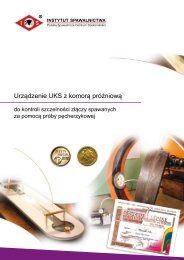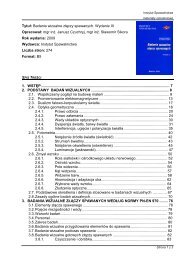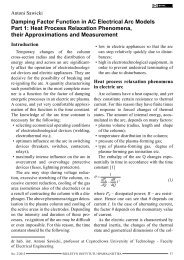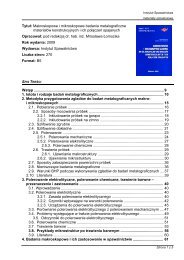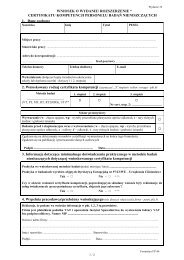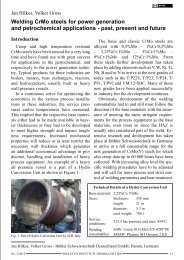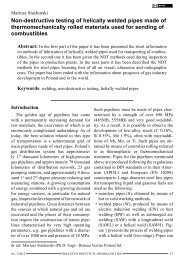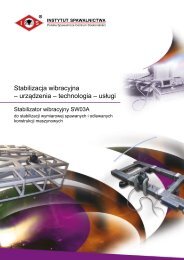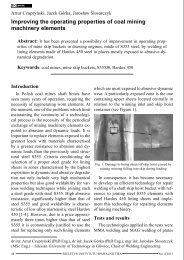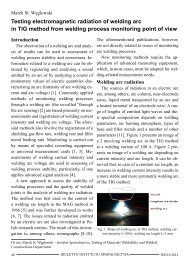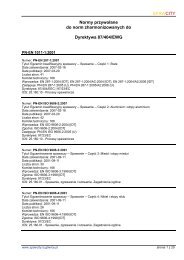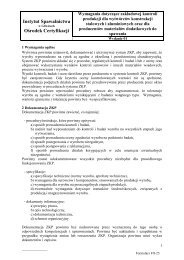Modern toughened steels - Biuletyn Instytutu Spawalnictwa
Modern toughened steels - Biuletyn Instytutu Spawalnictwa
Modern toughened steels - Biuletyn Instytutu Spawalnictwa
Create successful ePaper yourself
Turn your PDF publications into a flip-book with our unique Google optimized e-Paper software.
Marek St. Węglowski<br />
<strong>Modern</strong> <strong>toughened</strong> <strong>steels</strong> – their properties and advantages<br />
Introduction<br />
For years, metallurgists have been searching<br />
for ways of producing structural <strong>steels</strong><br />
which would have the highest possible mechanical<br />
properties and maintain satisfactory<br />
plastic properties at the same time. Due to<br />
an increase in yield point, it is now possible<br />
to manufacture structures consisting of elements<br />
of smaller wall thickness, thus lighter<br />
and less expensive to transport. A smaller<br />
wall thickness requires a smaller amount<br />
of filler metals and a shorter welding time.<br />
An increase in the mechanical properties of<br />
<strong>steels</strong> may be obtained by an appropriate selection<br />
of chemical composition through a<br />
classic process of toughening (hardening and<br />
tempering) or by means of thermo-mechanical<br />
treatment. However, no matter how high<br />
its mechanical properties might be, structural<br />
steel will only have practical application if it<br />
can be welded by means of commonly used<br />
Fig. 1. Development of structural <strong>steels</strong> (TMCP – Thermo-Mechanical-<br />
Control-Process – process of thermo-mechanical rolling) [1]<br />
arc methods. Toughened <strong>steels</strong> offer such a<br />
possibility. Due to the appropriate selection<br />
of chemical composition and proper heat treatment,<br />
i.e. hardening and tempering, these<br />
<strong>steels</strong> are characterised by very good mechanical<br />
properties as well as good weldability.<br />
Toughened <strong>steels</strong><br />
The recent development of structural<br />
<strong>steels</strong> has involved on one hand <strong>toughened</strong><br />
<strong>steels</strong> such as S690Q, S890Q and S960Q and<br />
on the other hand thermo-mechanically rolled<br />
<strong>steels</strong> of lower mechanical properties but<br />
of a higher impact strength (S355M, S460M<br />
and S500M). The development of structural<br />
<strong>steels</strong> is presented in chronological order in<br />
Figure 1 [1]. The division of <strong>toughened</strong> <strong>steels</strong><br />
into sub-groups, in accordance with Technical<br />
Report CEN TR ISO 15608 [2], is shown<br />
in Table 1.<br />
Toughened <strong>steels</strong> are fine-grained alloy<br />
<strong>steels</strong>. By selecting a proper chemical<br />
composition as well as the<br />
conditions of rolling and heat<br />
treatment, one obtains <strong>steels</strong><br />
having different levels of<br />
yield point ranging from 460<br />
to 1300 MPa. These <strong>steels</strong><br />
contain chromium and molybdenum<br />
which decrease critical<br />
cooling rate and increase<br />
hardenability. The presence of<br />
niobium or vanadium in these<br />
<strong>steels</strong> guarantees obtaining<br />
fine grains of austenite during<br />
Dr inż. Marek St. Węglowski – Instytut <strong>Spawalnictwa</strong>, Zakład Badań Spawalności i Konstrukcji<br />
Spawanych /Testing of Materials Weldability and Welded Constructions Department/<br />
NR 02/2012<br />
BIULETYN INSTYTUTU SPAWALNICTWA<br />
25
Table 1. Division of <strong>toughened</strong> <strong>steels</strong> into sub-groups according to Technical Report CEN TR ISO 15608 [2, 3]<br />
Examples of steel designation<br />
Group and subgroup<br />
number<br />
Steel designation<br />
In accordance with<br />
standard:<br />
Toughened <strong>steels</strong> with a yield point of 360 MPa < Re ≤ 690 MPa<br />
S460Q, S460QL, S460QL1, S500Q, S500QL, S500QL1,<br />
S550Q, S550QL, S550QL1, S620Q, S620QL1, S690QH, PN-EN 10025-6 [4]<br />
S690QL, S690QL1<br />
P460Q, P460QH, P460QL1, P460QL2, P500Q, P500QH,<br />
PN-EN 10028-6 [5]<br />
P500QL1, P500QL2, P690Q, P690QL1, P690QL2<br />
C35E, C35R, C40E, C40R, C45E, C45R, C50E, C50R, C55E,<br />
PN-EN 10083-2 [6]<br />
C55R, C60E, C60R, 28Mn6<br />
3.1<br />
L415QB, L450QB, L485QB, L555QB PN-EN 10208-2 [7]<br />
38Cr2, 46Cr2 PN-EN 10083-3 [8]<br />
P620Q, P620QH, P620QL PN-EN 10216-3 [9]<br />
P420QH PN-EN 10222-4 [10]<br />
A420, D420, E420, F420, A460, D460, E460, F460, A500,<br />
D500, E500, F500, A550, D550, E550, F550, A620, D620,<br />
E620, F620, A690, D690, E690, E690, F690<br />
Toughened <strong>steels</strong> with a yield point of Re > 690 MPa<br />
34Cr4, 34CrS4, 37Cr4, 37CrS4, 41Cr4, 41CrS4, 25CrMo4,<br />
25CrMoS4, 34CrMo4, 34CrMoS4, 42CrMo4, 42CrMoS4,<br />
3.2<br />
50CrMo4, 34CrNiMo6, 30CrNiMo8, 36CrNiMo16, 51CrV4<br />
Regulations PRS,<br />
Part IX [11]<br />
PN-EN 10083-3<br />
S890Q, S890QL, S890QL1, S960Q, S960QL PN-EN 10025-6<br />
Precipitation-hardened <strong>steels</strong> with the exception of corrosion-resistant <strong>steels</strong> (stainless steel)<br />
S500A, S500AL, S550A, S550AL, S620A, S620AL, S690A, PN-EN 10137-3<br />
3.3<br />
S690AL<br />
[12]<br />
Fig. 2. CCT diagram for welding conditions showing<br />
the impact of boron micro-addition on the curves of<br />
the beginning of cooled austenite transformations in of<br />
Mn-Cr-Mo-Ti steel in the function of time t 8/5<br />
: - - steel<br />
without boron, ― steel with boron, (0.17% C; 0.85%<br />
Mn; 0.005% N; 0.30% Cr; 0.85% Mo; 0.03% Ti;<br />
0.0016%) B [14]<br />
rolling and thus very tiny lamellas of supersaturated<br />
ferrite (martensite) after cooling.<br />
Tempering at a temperature of about 600ºC<br />
results in a high level of mechanical properties<br />
and good plasticity. Additionally, the<br />
increase in mechanical properties may be<br />
caused by precipitation hardening of NbC<br />
or V 4<br />
C 3<br />
. The role of nickel is to improve impact<br />
strength [13].<br />
The hardenability of such <strong>steels</strong> can be<br />
improved by introducing a micro-addition<br />
of boron below 0.005%. It is effective only<br />
in dissolved state in the solid solution. Through<br />
segregation on the austenite grain boundaries,<br />
it decreases the energy of lattice<br />
defects, delays the nucleation in γ → α decay<br />
and decreases the critical cooling rate.<br />
26 BIULETYN INSTYTUTU SPAWALNICTWA<br />
NR 02/2012
A desired effect is obtained<br />
only in the case of steel<br />
characterised by high metallurgical<br />
purity. That is<br />
due to the fact that because<br />
of a significant affinity for<br />
oxygen and nitrogen, this<br />
element binds to B 2<br />
O 3<br />
oxide<br />
in liquid metal passing<br />
into slag and, in solid state,<br />
into a stable BN nitride.<br />
The nitride, however, dissolves<br />
in the solid solution,<br />
yet this process requires a high temperature<br />
of austenitising, at which AlN also dissolves<br />
and so does part of MX phases of micro-additions<br />
introduced into the steel. This<br />
is a typical reason for the disadvantageous<br />
growth of austenite grains and worsening of<br />
steel ductility.<br />
One may prevent the formation of a BN<br />
nitride by introducing into the steel an element<br />
of a greater affinity for nitrogen than<br />
boron. The most effective protection for boron,<br />
without worsening the ductility of steel,<br />
is the introduction of titanium into the bath.<br />
The amount of titanium should be sufficient<br />
to bind nitride in TiN [14].<br />
NR 02/2012<br />
Fig. 3. Impact of tempering temperature on yield point a) and impact strength<br />
b) of three <strong>toughened</strong> <strong>steels</strong> [13]<br />
Element [ppm]<br />
BIULETYN INSTYTUTU SPAWALNICTWA<br />
High strength <strong>steels</strong><br />
are melted in oxygen converters<br />
and then subjected<br />
to degassing in<br />
vacuum. In order to<br />
carry out desulfurization<br />
of the bath one<br />
introduces into it calcium<br />
compounds by<br />
means of argon stream<br />
as a carrier gas. Apart<br />
from considerable desulfurization,<br />
it causes<br />
the deoxidation and homogenization of<br />
the melt. This process also enables controlling<br />
the shape of sulphides which remain<br />
in the steel. Steels melted in such a way are<br />
characterized by high resistance to lamellar<br />
cracking. The <strong>steels</strong> are usually melted<br />
in a continuous way. After the typical process<br />
of rolling, the sheets/plates are heated<br />
up to the temperature of austenitizing and<br />
cooled by means of high-pressure spraying<br />
devices. The tempering of steel takes place<br />
in the next furnace. After the tempering<br />
the steel is characterised by a fine-grained<br />
structure with dispersive carbides and a<br />
favourable combination of strength and impact<br />
resistance (see Figure 3) [13].<br />
Table 2. Impact of development of metallurgical processes on the level of impurities<br />
in steel [15, 16]<br />
Metallurgical<br />
processes in the<br />
years 1950/1960<br />
Metallurgical<br />
processes in the<br />
years 1980/1990<br />
Metallurgical<br />
processes in the<br />
years 1990/2010 2)<br />
Sulphur 100-300 50-80 60<br />
Phosphorus 150-300 80-140 6<br />
Hydrogen 4-6 3-5 -<br />
Nitrogen 80-150
Table 3. Examples of designation of <strong>toughened</strong> <strong>steels</strong> acc. to their manufacturers<br />
Range of<br />
Steel manufacturer<br />
PN EN PN EN<br />
thickness<br />
Thyssen- Dillinger<br />
10025-6 10027-2<br />
Salzgitter<br />
FaFer SSAB<br />
[mm]<br />
Krupp Stahl Hütte<br />
S690QL 1.8928 3-200 Maxil 690 Naxtra 70 Dillimax 690T Supralsim 690 Weldox 700 E<br />
S890QL 1.8983 4-120 Maxil 890 Xabo 890 Dillimax 890T Supralsim 890 Weldox 900 E<br />
S960QL 1.8933 4-100 Maxil 960 Xabo 960 Dillimax 965T Supralsim 960 Q Weldox 960 E<br />
Table 4. Chemical composition of Weldox type steel [18-22]<br />
Steel<br />
Chemical composition of steel [%]<br />
designation 1) C Si Mn B Nb Cr V Cu Ti Al Mo Ni N<br />
WELDOX 700 0.20 0.60 1.60 0.005 0.04 0.70 0.09 0.30 0.04 0.015 0.70 2.00 0.010<br />
WELDOX 900 0.20 0.50 1.60 0.005 0.04 0.70 0.06 0.10 0.04 0.018 0.70 2.00 0.010<br />
WELDOX 960 0.20 0.50 1.60 0.005 0.04 0.70 0.06 0.15 0.04 0.018 0.70 1.5 0.010<br />
WELDOX 1100 0.21 0.50 1.40 0.005 0.04 0.80 0.08 0.10 0.02 0.020 0.70 3.00 0.010<br />
WELDOX 1300 0.25 0.50 1.40 0.005 0.04 0.80 0.08 0.10 0.02 0.020 0.70 2.0 0.010<br />
1)<br />
steel designation by SSAB<br />
The development of steel metallurgical<br />
processes aims on one hand at the growth of<br />
efficiency (reduction of production costs),<br />
and on the other at decreasing disadvantageous<br />
impurities in steel (Table 2) which could<br />
cause, e.g. lamellar or hot cracking.<br />
Toughened <strong>steels</strong> may also be manufactured<br />
by means of a method of direct hardening<br />
of plates/sheets at the temperature<br />
of rolling, i.e. in the process of thermo-mechanical<br />
treatment. Such a method allows<br />
one to obtain, with the same chemical composition,<br />
a yield point higher by approximately<br />
130 MPa than the one obtained in<br />
a conventional toughening process. By applying<br />
this method one can produce <strong>steels</strong><br />
which have a carbon equivalent lower by<br />
approximately 0.05%. Such <strong>steels</strong> are characterised<br />
by better weldability in comparison<br />
with <strong>steels</strong> produced in a conventional<br />
way [13]. Approximate diagrams of the<br />
production processes of <strong>toughened</strong> <strong>steels</strong><br />
are shown in Figure 4.<br />
Global manufacturers of <strong>toughened</strong> <strong>steels</strong><br />
(such as SSAB, Salzgitter, Dillinger Hütte<br />
and others) introduced their own systems of<br />
steel designation. Exemplary designations<br />
are presented in Table 3. Tables 4-8 contain<br />
<strong>steels</strong> of HSLA group (High Strength Low<br />
Alloy), their chemical composition as well<br />
Fig. 4. Diagrams of production processes of <strong>toughened</strong> <strong>steels</strong> a) hardening and tempering processes,<br />
b) direct hardening process.<br />
28 BIULETYN INSTYTUTU SPAWALNICTWA<br />
NR 02/2012
Table 5. Designation of high strength <strong>steels</strong> according to SSAB<br />
company [23] and PN EN 10025-6:2009 standard [4]<br />
No.<br />
Designation<br />
according to SSAB<br />
Re<br />
[MPa]<br />
Meeting<br />
KV*<br />
criteria<br />
as mechanical and plastic properties on the<br />
basis of the requirements of standard PN<br />
-EN 10025-6 and SSAB company data. In<br />
Designation<br />
according to<br />
standard PN-EN<br />
10025-6:2009<br />
1 Weldox 700 D<br />
- 20 S 690 Q<br />
2 Weldox 700 E 700 - 40 S 690 QL<br />
3 Weldox 700 F - 60 S 690 QL1<br />
4 Weldox 900 D<br />
- 20 S 890 Q<br />
5 Weldox 900 E 900 - 40 S 890 QL<br />
6 Weldox 900 F - 60 S 890 QL1<br />
7 Weldox 960 D<br />
- 20 S 960 Q<br />
960<br />
8 Weldox 960 E - 40 S 960 QL<br />
9 Weldox 1100 E<br />
- 40 no equivalent<br />
110<br />
10 Weldox 1100 F - 60 no equivalent<br />
11 Weldox 1300 E<br />
- 40 no equivalent<br />
1300<br />
12 Weldox 1300 F -60 no equivalent<br />
*/ min. 27 J at fracture temperature<br />
Table 6. Mechanical properties of Weldox type steel as well as CE<br />
and CET values [18-22]<br />
Carbon<br />
Mechanical properties<br />
Steel designation<br />
equivalents<br />
Re<br />
A<br />
Rm [MPa] 5<br />
CE*<br />
[MPa]<br />
[%] [%]<br />
WELDOX 700 700 780-930 14 0.43 0.29<br />
WELDOX 900 900 940-1100 12 0.55 0.36<br />
WELDOX 960 960 980-1150 12 0.55 0.37<br />
WELDOX 1100 1100 1250-1550 10 0.59 0.35<br />
WELDOX 1300 1300 1400-1700 8 0.65 0.42<br />
*CE = C+Mn/6+(Cr+Mn+V)/15+(Ni+Cu)/15;<br />
**CET= C+(Mn+Mo)/10+(Cr+Cu)/15+Ni/40<br />
order to compare these <strong>steels</strong>, the<br />
mechanical properties were referred<br />
to sheet/plate thickness up to<br />
10 mm (Fig. 5-7).<br />
Due to difficulty ensuring uniform<br />
mechanical properties on<br />
the thickness of a finished product<br />
made of <strong>toughened</strong> steel, an<br />
increase in mechanical properties<br />
(Re) is accompanied by a decrease<br />
in the maximum thickness of<br />
available sheets. This fact is related<br />
to hardening and tempering<br />
processes. An example of the maximum<br />
thickness of sheets made<br />
of Weldox steel (the company<br />
SSAB) is presented in Figure 6. It<br />
can be expected that a range of available<br />
thicknesses will grow along<br />
with the development of metallurgical<br />
processes.<br />
CET**<br />
[%]<br />
Taking into consideration the<br />
chemical composition of <strong>toughened</strong><br />
<strong>steels</strong> (Tables 4 and 7), one<br />
can suppose that these <strong>steels</strong> can<br />
cause problems during welding.<br />
Figure 7 presents the impact<br />
of carbon content and a carbon<br />
equivalent CE on the weldability<br />
of structural steel according to Graville<br />
Fig. 5. Mechanical properties of steel Weldox [18-22]<br />
Fig. 6. Maximum thickness of standard sheets made of<br />
steel Weldox, other thicknesses available on the basis of<br />
individual orders [24-28]<br />
NR 02/2012<br />
BIULETYN INSTYTUTU SPAWALNICTWA<br />
29
Table 7. Chemical composition of <strong>toughened</strong> <strong>steels</strong> according to PN-EN 10025-6 [4]<br />
Steel<br />
Steel chemical composition [%] max<br />
designation C Si Mn B Nb Cr V Cu Ti Al Mo Ni N P S<br />
S…Q<br />
0.025 0.015<br />
S…QL 0.20 0.80 1.70 0.005 0.06 1.50 0.12 0.50 0.05 - 0.70 2.00 0.015 0.020 0.010<br />
S…QL1 0.020 0.010<br />
[29]. Due to the fact that <strong>steels</strong> after hardening<br />
and tempering are characterised by<br />
a carbon equivalent exceeding 0.5% and<br />
that carbon content in these <strong>steels</strong> exceeds<br />
0.1%, they are included in zone III. For this<br />
reason it is necessary to use low-hydrogen<br />
welding processes and preheating.<br />
Due to very high mechanical properties,<br />
<strong>steels</strong> of a yield point in excess of 1100 MPa<br />
have found application in the production of<br />
high-loaded elements of car lifts, travelling<br />
cranes and special bridge structures.<br />
The advantages of using <strong>steels</strong> with high<br />
mechanical properties are visible as regards<br />
the costs of transport, plastic working,<br />
cutting, and welding. Table 9 presents the<br />
comparison of the relative values of technical<br />
parameters in the production of a model<br />
element made of steel S235, S700 and<br />
S960.<br />
Tests conducted at Luleå University (Sweden)<br />
have revealed that the use of steel with a<br />
higher yield point provides economic benefits<br />
for manufacturers of cranes (Table 10) [31].<br />
The redesign of a given crane element and<br />
replacing steel Domex 900 with steel Weldox<br />
1100 resulted in the reduction of [31] the following:<br />
• wall thickness from 6 mm to 4 mm, and thus<br />
the reduction of the crane weight or an increase<br />
in the lifting capacity without increasing<br />
the crane weight,<br />
• costs of materials even if the price of Weldox<br />
steel is higher, as less Weldox steel was<br />
used than Domex steel,<br />
• amount of filler metals and lower costs related<br />
to welding time, as sheets of a smaller<br />
thickness were used,<br />
• fuel, owing to the smaller weight of the crane.<br />
Fig. 8. Mechanical properties of <strong>toughened</strong> <strong>steels</strong> [4]<br />
Fig. 7. Impact of carbon content and carbon equivalent<br />
CE on structural weldability : I – zone free from susceptibility<br />
to cracking, II – zone with susceptibility to<br />
cracking depending on welding conditions, III – zone of<br />
high susceptibility to cracking independent of welding<br />
conditions [29]<br />
The reference publications contain mainly<br />
test results for <strong>toughened</strong> <strong>steels</strong> with a yield<br />
point of up to 1100 MPa. This is due to the fact<br />
that the <strong>steels</strong> of a yield point of 1300 MPa<br />
are relatively new on the market and have not<br />
been a subject of intensive research so far.<br />
30 BIULETYN INSTYTUTU SPAWALNICTWA<br />
NR 02/2012
Table 8. Mechanical properties of <strong>toughened</strong> <strong>steels</strong> according<br />
to PN-EN 10025-6 [4]<br />
Steel<br />
designation<br />
Mechanical properties<br />
Re [MPa] Rm [MPa] A 5<br />
[%]<br />
S 460 460 550-720 17<br />
S 500 500 590-770 17<br />
S 550 550 640-820 16<br />
S 620 620 700-890 15<br />
S 690 690 770-940 14<br />
S 890 890 940-1100 11<br />
S 960 960 980-1150 10<br />
Table 9. Comparison of relative values of technical parameters<br />
depending on steel grade [30]<br />
Steel grade [MPa] 235 700 960<br />
Thickness [mm] 15 6 4<br />
Amount of weld deposit [%] 100 16 7<br />
Time of laser beam cutting [%] 100 40 27<br />
Required bending force [%] 100 32 19<br />
Required bending radius [%] 100 23 30<br />
Weight of element [%] 100 44 30<br />
Note: calculations were made of the closed profile<br />
120×80 mm, V- bevelled butt joint, using a bending moment<br />
of 50kNm<br />
Table 10. Costs of producing a crane structural element<br />
in case of changing structural material [31]<br />
Costs (euro)<br />
Steel<br />
Steel<br />
Domex 900 Weldox 1100<br />
Material 353.60 284.28<br />
Cutting 2.45 2.83<br />
Bending 0.013 0.014<br />
Welding 15.24 11.31<br />
Total 371.30 298.43<br />
Even the calculations contained in standard<br />
Eurocode 3 [32] do not take into account<br />
<strong>steels</strong> with a yield point of 1100 MPa and<br />
higher. This is due to insufficient knowledge<br />
about the fatigue strength and the buckling<br />
phenomenon related to these <strong>steels</strong>.<br />
The use of <strong>toughened</strong> <strong>steels</strong> of a yield point<br />
higher than 1000 MPa in the production<br />
of critically important structures exposed to<br />
variable loads imposes a necessity of carrying<br />
out, among others, fatigue tests. Equally<br />
important is the determination of usability<br />
of methods increasing fatigue strength,<br />
consisting in TIG-remelting, grinding and<br />
ultrasonic machining of the welded joint.<br />
The results of the fatigue strength tests [33]<br />
of the welded joints made of <strong>toughened</strong> steel<br />
grade S700 (steel Domex 700 manufactured<br />
by SSAB) reveal that TIG-remelting increases<br />
the fatigue strength of joints (100 000<br />
cycles ) by 38%, grinding by 31%, and ultrasonic<br />
machining makes it possible to increase<br />
fatigue strength on the average by 33%.<br />
Also in the case of the welded joints made of<br />
<strong>steels</strong> with higher yield points, i.e. 960 and<br />
1100 MPa, subjected to additional surface<br />
treatment (TIG remelting and grinding), it<br />
was possible to observe an increase in their<br />
fatigue strength. The authors [34] obtained<br />
results of fatigue tests on the basis of which<br />
they suggested changing the class of a joint<br />
welded according to Eurocode 3 (fatigue category<br />
FAT) to 112 MPa for a joint subjected<br />
to grinding and to 140 MPa for a TIG-remelted<br />
joint. The welded joint not subjected to<br />
machining was classified as 100 MPa.<br />
From a practical point of view, another<br />
important phenomenon occurring in <strong>steels</strong> of<br />
a high yield point is buckling – depending,<br />
first of all, on the geometry of an element<br />
[35], but also on loading conditions, welding<br />
imperfections, level of remaining stresses<br />
and material properties. The authors [34] demonstrated<br />
that currently applied calculation<br />
principles allow changing the standard Eurocode<br />
and extending it by the steel of a yield<br />
point Re = 1100 MPa.<br />
Weldability of <strong>toughened</strong> <strong>steels</strong><br />
While developing a technology for welding<br />
<strong>steels</strong> of high mechanical properties it is<br />
of great importance to properly select a filler<br />
metal. In order to do so one should take into<br />
consideration the following [36]:<br />
NR 02/2012<br />
BIULETYN INSTYTUTU SPAWALNICTWA<br />
31
• chemical composition, microstructure,<br />
mechanical properties (ultimate strength<br />
and toughness) of the steel to be welded,<br />
• design requirements related to the minimum<br />
ultimate strength and toughness,<br />
• mechanical properties of a filler metal, minimum<br />
ultimate strength and toughness,<br />
• chemical composition of the weld deposit;<br />
the carbon content should be lower by<br />
a minimum of 0.02 percentage by weight<br />
than the carbon content in the steel to be<br />
welded, and the temperature of the phase<br />
transition should be lower by a minimum<br />
of 30°C than a transformation temperature<br />
in the steel being tested.<br />
The ultimate strength is one of the most<br />
important criteria used in selecting a filler<br />
metal . A filler metal may have higher<br />
or lower ultimate strength than that of the<br />
parent metal [36]. The authors [37] investigated<br />
the impact of the ultimate strength<br />
of a weld deposit on the properties of the<br />
whole joint, and demonstrated that for<br />
steel S960 one can adopt the dependence:<br />
A weld<br />
/A sheet<br />
≥R msheet<br />
/R mweld<br />
deposit, where A<br />
is the area of cross-section, R m<br />
– ultimate<br />
strength.<br />
While selecting proper welding conditions,<br />
one should pay attention not only<br />
to choosing a proper filler metal but also to<br />
selecting proper welding parameters. The<br />
results of the tests conducted on the joints<br />
made of steel grade S650 revealed that the<br />
use of current parameters ensuring the amount<br />
of supplied heat at a level exceeding 32<br />
kJ/cm causes a radical decrease in ultimate<br />
strength irrespective of the mechanical<br />
properties of a weld deposit [38]. If one<br />
compares the welding conditions of three<br />
<strong>steels</strong> of various yield points and subjected<br />
to various thermo-mechanical treatment,<br />
32 BIULETYN INSTYTUTU SPAWALNICTWA<br />
one can observe that welding <strong>toughened</strong><br />
<strong>steels</strong>, if compared with welding thermo<br />
-mechanically rolled <strong>steels</strong>, requires the use<br />
of welding conditions of significantly narrower<br />
allowed variability limits (Fig. 9) [1].<br />
Fig. 9. Typical welding conditions for structural <strong>steels</strong><br />
(S355J2 – 80 mm, S500M – 50 mm, S690QL – 30 mm) [1]<br />
One should not neglect the fact that <strong>steels</strong><br />
of high mechanical properties are susceptible<br />
to cold cracking and that hydrogen diffusion<br />
is a function of time. For this reason<br />
it is of crucial importance that NDT should<br />
be carried out no earlier than 48 hours after<br />
the completion of a welding process [39].<br />
There were cases when <strong>toughened</strong> <strong>steels</strong><br />
developed cold cracks after 3-4 weeks [40,<br />
41]. These recommendations are also contained<br />
in standards PN-EN ISO 17642-2:2005<br />
[42] and PN-EN 1090:2009 [43]. In some<br />
cases it is possible to use post-weld heat treatment<br />
in order to prevent cold cracks (stress<br />
relief annealing in the range 530 - 580°C).<br />
Thanks to this process, hydrogen present in<br />
the weld area diffuses towards outside the<br />
joint more easily [44], and the susceptibility<br />
to cold cracking is less. The tests results<br />
obtained so far reveal that an increase in the<br />
yield point (Re) or hardness (HV) of a parent<br />
metal [44, 45] or weld deposit [46] is<br />
accompanied by a decrease in the allowed<br />
NR 02/2012
hydrogen content in a metal, above which<br />
once can observe a growing susceptibility<br />
to cold cracking. The test results for the parent<br />
metal are presented in Figure 10, and<br />
for the weld deposit in Figure 11.<br />
Fig. 10. Allowed hydrogen content in parent metal depending<br />
on steel grade (yield point) [44]<br />
Fig. 11. Allowed hydrogen content in weld deposit<br />
depending on the grade of filler metal<br />
(weld deposit hardness) [46]<br />
NR 02/2012<br />
BIULETYN INSTYTUTU SPAWALNICTWA<br />
It is important that the content of diffusing<br />
hydrogen, while welding with flux<br />
cored wires, is in direct proportion to the value<br />
of welding current and arc voltage and<br />
in inverse proportion to the exposed length<br />
of an electrode [47], or more precisely, the<br />
distance between the surface of a material<br />
being welded and a contact tube. Obviously,<br />
the amount of hydrogen also depends on the<br />
type of shielding gas, parent and filler metals<br />
as well as the weather conditions.<br />
While developing a technology for welding<br />
<strong>toughened</strong> <strong>steels</strong> characterised by high<br />
mechanical properties, one should also focus<br />
on, apart from cold crack formation,<br />
such phenomena as the following:<br />
• welding-induced HAZ softening (the socalled<br />
”soft layer issue ”),<br />
• failure to obtain a required toughness level<br />
in the weld and HAZ (brittleness caused<br />
by ageing and precipitation hardening).<br />
Soft layer issue<br />
During welding <strong>toughened</strong> <strong>steels</strong> their<br />
HAZ develops a softened microstructure<br />
area of worse mechanical properties.<br />
This phenomenon is particularly visible in<br />
<strong>steels</strong> after rolling and intensified cooling.<br />
Figure 12 presents hardness changes in the<br />
cross-section of the welded joint made of<br />
<strong>toughened</strong> steel (QT). In the HAZ of <strong>toughened</strong><br />
steel a hardness decrease is to a<br />
little extent caused by phase transitions;<br />
much greater in this case is the impact of<br />
tempering. Welding with the limited linear<br />
energy of an arc makes the layer narrow. In<br />
this case, although the hardness of this layer<br />
is lower, this fact, due to a narrow softening<br />
zone, does not have to result in the deterioration<br />
of the mechanical properties of<br />
the joint, because of the so called “contact<br />
strengthening” phenomenon generated by<br />
flat strains triggered in the soft layer [13].<br />
Fig. 12. Hardness distribution HV in welded joint made<br />
of <strong>toughened</strong> steel of Re>500MPa (QT), t 8/5<br />
=30s [13]<br />
33
Failing to obtain required toughness<br />
in the weld and HAZ<br />
An increase in HAZ hardenability due to<br />
the dissolution of micro-additions causes a<br />
shift of transformation curves in the continuous<br />
TTT diagram towards a longer selfcooling<br />
time, resulting in an increase in a<br />
martensite and bainite content. These structures,<br />
combined with a grain size increase,<br />
may lead to toughness decrease, particularly<br />
if the linear energy of an arc is high. In joints<br />
welded with low linear energy, an increase<br />
in brittleness is barely visible. In the<br />
<strong>steels</strong> of a yield point over 445 MPa (steel<br />
X65) containing Nb, V and Mo, in the HAZ<br />
heated to the temperature of Ac3-Ac1 it is<br />
possible to observe a decrease in hardness.<br />
The decrease is lower with higher welding<br />
energy and longer cooling time 8/5 are. According<br />
to Tasak [48], the decrease in toughness<br />
is caused by the appearance of a<br />
ferrite structure with martensitic-austenitic<br />
islands (M-A). After reaching the temperature<br />
in the range of Ac1-Ac3, the pearlitic<br />
areas transform into austenite rich in carbon<br />
and alloying elements, which, during (even<br />
slow) cooling transforms into hard and brittle<br />
martensite and/or partly into retained austenite.<br />
The presence of hard and brittle M-A<br />
islands is responsible for the fact that during<br />
the impact test the martensitic areas crack<br />
spontaneously or facilitate the nucleation of<br />
cracks on the surface of the division ferrite<br />
-MA island, and thus decrease impact energy.<br />
For steel X-80 (Re>550 MPa) de Vito<br />
[13] determined the dependence between<br />
toughness KCV and the amount of the phase<br />
M-A: KCVmax=0.52AF+112exp (-0.042M-<br />
A), where AF - % content of acicular ferrite,<br />
M-A - % content of M-A islands.<br />
Summary<br />
Toughened <strong>steels</strong> have been produced for<br />
many years. For instance, steel S690 had its<br />
market introduction 30 years ago. Despite<br />
the passage of time, more and more grades<br />
of increasingly good mechanical properties<br />
have been produced. This process has been<br />
accompanied by a constant improvement of<br />
metallurgical processes aimed to reduce the<br />
level of impurities in <strong>steels</strong>, i.e. sulphur and<br />
phosphorus. As a result, manufactured materials<br />
represent relatively good weldability. In<br />
consequence, these <strong>steels</strong> find applications in<br />
many welded structures. Obviously, because<br />
of their worse plastic properties <strong>toughened</strong><br />
<strong>steels</strong> of very high mechanical properties<br />
cannot be used in the production of e.g.<br />
pressure equipment. It should also be remembered<br />
that <strong>toughened</strong> <strong>steels</strong> of a high yield<br />
point are susceptible to cold cracking which<br />
should be taken into consideration while<br />
selecting a welding technology. Another limitation<br />
during welding hardened and tempered<br />
<strong>steels</strong> is the presence of the so-called<br />
softening zone.<br />
References:<br />
[1] Willms R.: High strength steel for steel<br />
constructions. Nordic Steel Construction<br />
Conference – NSCC, 2009, 597-604.<br />
[2] ISO TR 15608 Spawanie. Wytyczne<br />
systemu podziału materiałów metalowych<br />
na grupy. NORMA WYCOFANA BEZ ZA-<br />
STĄPIENIA.<br />
[3] Przepisy Polskiego Rejestru Statków.<br />
Publikacja nr 3/P, Zasady egzaminowania<br />
spawaczy. 2010.<br />
[4] Norma PN-EN 10025:6:2009. Wyroby<br />
walcowane na gorąco ze stali konstrukcyjnej.<br />
Część 6: Warunki techniczne dostawy<br />
wyrobów płaskich o podwyższonej granicy<br />
34 BIULETYN INSTYTUTU SPAWALNICTWA<br />
NR 02/2012
plastyczności w stanie ulepszonym cieplnie.<br />
[5] PN-EN 10028-6:2010 Wyroby płaskie<br />
ze stali na urządzenia ciśnieniowe. Część 6:<br />
Stale spawalne drobnoziarniste ulepszone<br />
cieplnie.<br />
[6] PN-EN 10083-2:2008 Stale do ulepszania<br />
cieplnego. Część 2: Warunki techniczne<br />
dostawy stali niestopowych.<br />
[7] PN-EN 10208-2:2011 Rury stalowe<br />
przewodowe dla mediów palnych. Warunki<br />
techniczne dostawy. Część 2: Rury o klasie<br />
wymagań B.<br />
[8] PN-EN 10083-3:2008 Stale do ulepszania<br />
cieplnego. Część 3: Warunki techniczne<br />
dostawy stali stopowych.<br />
[9] PN-EN 10216-3:2004 Rury stalowe<br />
bez szwu do zastosowań ciśnieniowych. Warunki<br />
techniczne dostawy. Część 3: Rury ze<br />
stali stopowych drobnoziarnistych.<br />
[10] PN-EN 10222-4:2002 Odkuwki stalowe<br />
na urządzenia ciśnieniowe. Część 4:<br />
Stale spawalne drobnoziarniste o podwyższonej<br />
granicy plastyczności.<br />
[11] Przepisy Polskiego Rejestru Statków<br />
Część IX – Materiały i spawanie, 2008.<br />
[12] PN-EN 10137-3:2000. Blacha gruba i<br />
blacha uniwersalna ze stali konstrukcyjnej o<br />
podwyższonej wytrzymałości w stanie ulepszonym<br />
cieplnie lub utwardzonym wydzieleniowo.<br />
Warunki dostawy stali utwardzonych<br />
wydzieleniowo. NORMA WYCOFANA<br />
BEZ ZASTĄPIENIA.<br />
[13] Tasak E.: Metalurgia spawania. Wyd.<br />
JAK, Kraków, 2008.<br />
[14] Adamiec J.: Inżynieria wyrobów stalowych.<br />
Wyd. Politechniki Śląskiej, Gliwice,<br />
2000.<br />
[15] Grill R.: Advanced steel for heavy<br />
plates. Alloy design, plate production and<br />
properties. Materiały seminaryjne firmy Voestalpine,<br />
Stavanger, 2010.<br />
NR 02/2012<br />
BIULETYN INSTYTUTU SPAWALNICTWA<br />
[16] Bannenberg N.: Recent developments<br />
in steelmaking and casting. Proceedings<br />
of the International Symposium Niobium<br />
2001 held in Orlando, Florida, USA. December<br />
2-5, 2001.<br />
[17] Zeman M., Sitko E.: Przegląd stali o<br />
wysokiej i bardzo wysokiej wytrzymałości.<br />
<strong>Biuletyn</strong> <strong>Instytutu</strong> <strong>Spawalnictwa</strong>, 2007, nr 3,<br />
s. 30-38.<br />
[18] Materiały informacyjne firmy SSAB.<br />
DATA SHEET: Weldox 700, 2010.<br />
[19] Materiały informacyjne firmy SSAB.<br />
DATA SHEET: Weldox 900, 2009.<br />
[20] Materiały informacyjne firmy SSAB.<br />
DATA SHEET: Weldox 960, 2009.<br />
[21] Materiały informacyjne firmy SSAB.<br />
DATA SHEET: Weldox 1100, 2005<br />
[22] Materiały informacyjne firmy SSAB.<br />
DATA SHEET: Weldox 1300, 2005.<br />
[23] Materiały informacyjne firmy SSAB.<br />
General production information Weldox,<br />
Hardox, Armox and Toolox.<br />
[24] Materiały informacyjne firmy SSAB.<br />
Weldox 700 dimensions, 2008.<br />
[25] Materiały informacyjne firmy SSAB.<br />
Weldox 900 dimensions, 2007.<br />
[26] Materiały informacyjne firmy SSAB.<br />
Weldox 960 dimensions, 2007.<br />
[27] Materiały informacyjne firmy SSAB.<br />
Weldox 1100 dimensions, 2007.<br />
[28] Materiały informacyjne firmy SSAB.<br />
Weldox 1300 dimensions, 2007.<br />
[29] Graville, B.A.: Cold Cracking in<br />
Welds in HSLA Steels. Welding of HSLA<br />
(Microalloyed) Structural Steels. Proceedings<br />
International Conference on Welding<br />
of HSLA (Microalloyed) Structural Steels,<br />
Rome, Italy (ASM International, Materials<br />
Park, OH, November 9-12,1976).<br />
[30] Materiały firmy VoestAlpine: High<br />
-strength and ultra-high-strength cut shapes<br />
35
from hot-rolled steel strip.<br />
[31] German R.C.: Manufacturing sustainability<br />
and reengineering analysis of a crane<br />
boom member. Praca magisterska Lulea<br />
University of Technology, 2009.<br />
[32] Norma Eurocode 3 Steel.<br />
[33] Pedersen M.M., Mouritsen O.O. i<br />
inni: Comparision of post-weld treatment of<br />
high-strength steel welded joints in medium<br />
cycle fatigue. Welding in the World, 2010, t.<br />
54, nr 7/8, s. R208-R217.<br />
[34] Lieurade H.P., Huther I., Lefebvre F.:<br />
Effect of Weld Quality and Post Weld Improvement<br />
Techniques on the Fatigue Resistance<br />
of Extra High Strength Steels. Welding in<br />
the World, 2008, t. 52, nr 7/8, s. 106-115.<br />
[35] Sedlacek G., Volling B., Pak D., Feldman<br />
M.: Local buckling behaviour of cold<br />
-formed RHS made from S1100. Welding in<br />
the World, 2006, t. 50, nr 8/9, wyd. spec., s.<br />
133-138.<br />
[36] Sampath K.: How to choose electrodes<br />
for joining high-strength <strong>steels</strong>. Welding<br />
Journal, 2007, t. 86, nr 7, s. 26-28.<br />
[37] Kolstein M.H., Dijkstra O.D.: Tests<br />
on welded connections made of high strength<br />
steel up to 1100 MPa. Welding in the World,<br />
2006, t. 50, nr 8/9, wyd. spec., s. 512-519.<br />
[38] Mochozuki M., Shintomi T., Hashimoto<br />
Y., Toyoda M.: Analytical study on<br />
deformation and strength in HAZ-softened<br />
welded joints of fine-grained <strong>steels</strong>. Welding<br />
in the World, 2004, t. 48, nr 9/10, s. 2-12.<br />
[39] Enzinger N., Cerjak H.: Characterisation<br />
of cracks in high strength steel weldments.<br />
Welding in the World, 2007, t. 51, nr<br />
11/12, s. 29-33.<br />
[40] Kuebler R., Pitrun M., Pitrun I.: The<br />
effect of welding parameters and hydrogen<br />
levels on the weldability of high strength<br />
Q&T steel welded with FCAW consumables.<br />
Welding Journal, 2000, t. 45, nr 1, s. 38-47.<br />
[41] Sterjovski Z., Carr D.G., Holdstock<br />
R., Nolan D., Norrish J.: A non-destructive<br />
evaluation of transverse hydrogen cracking<br />
in high strength flux-cored weld metal. Australian<br />
Welding Journal, 2007, vol. 52, nr 1,<br />
s. 40-48.<br />
[42] PN-EN ISO 17642-2:2005. Badania<br />
niszczące spoin w metalach. Badania pękania<br />
na zimno złączy spawanych. Metody spawania<br />
łukowego. Część 2: próby z utwierdzeniem<br />
własnym.<br />
[43] PN-EN 1090-2:2009 Wykonanie konstrukcji<br />
stalowych i aluminiowych. Część 2:<br />
Wymagania techniczne dotyczące konstrukcji<br />
stalowych.<br />
[44] Wongpanya P., Boellinghaus Th.,<br />
Lothongkum G.: Effect of hydrogen removal<br />
heat treatment on residual stresses in high<br />
strength steel welds. Welding in the World,<br />
2006, t. 50, nr 8/9, s. 96-103.<br />
[45] Mee V.J.H.M., Jansen H., Kalfsbeek<br />
B., Etteger P.: Consumables and practices for<br />
welding high strength <strong>steels</strong>. Welding in the<br />
World, 2007, t.51, nr 7, s. 271-280.<br />
[46] Nevasmaa P.: Prevention of weld metal<br />
hydrogen cracking in high strength multipass<br />
welds. Welding in the World, 2004, vol.<br />
48, nr 5/6, s. 2-18.<br />
[47] Pitrun M., Nolan D., Dunne D.: Correlation<br />
of welding parameters and diffusible<br />
hydrogen content in rutile flux-cored arc<br />
welds. Australian Welding Journal, 2004,<br />
vol. 49, nr 1, s. 33-46.<br />
[48] Tasak E., Ziewiec A.: Metalurgiczne<br />
problemy spawania wybranych stali konstrukcyjnych.<br />
Przegląd <strong>Spawalnictwa</strong>, 2008,<br />
t. 80, vol. 10, s. 59-64.<br />
36 BIULETYN INSTYTUTU SPAWALNICTWA<br />
NR 02/2012



